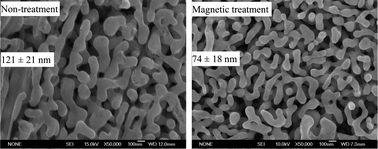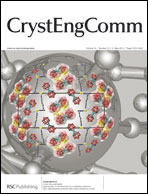The dealloying behavior of bi-phase Al–Ag alloys in 5 wt.% HCl in non-treated and magnetic treated conditions was comparatively investigated. The as-dealloyed samples were characterized by X-ray diffraction (XRD), scanning electron microscopy (SEM), and energy dispersive X-ray (EDX) analysis coupled with SEM. The results reveal that an external magnetic field would accelerate the dealloying process and the as-dealloyed samples from magnetic treatment are characterized by a finer and more homogeneous three dimensional (3D) bi-continuous nanoporous structure compared with those from non-treatment dealloying. The smaller diffusion coefficient (Ds) of silver and the larger diffusion activation energy (Eα) under a magnetic field can be responsible for the finer nanoporous structure. It is deemed that the formation of diamagnetic reaction products (during the etching of Al) and the crystal nucleation of silver (during the dealloying of Ag2Al) are accelerated by the external magnetic field. In addition, not only the pre-exponential factor (D0), obtained from the Arrhenius equation for diffusion of Ag, but also the activation energy (Eα) were influenced by the magnetic field, implying that different diffusion mechanisms and also the complicated underlying dealloying mechanism were involved.

You have access to this article
 Please wait while we load your content...
Something went wrong. Try again?
Please wait while we load your content...
Something went wrong. Try again?


 Please wait while we load your content...
Please wait while we load your content...